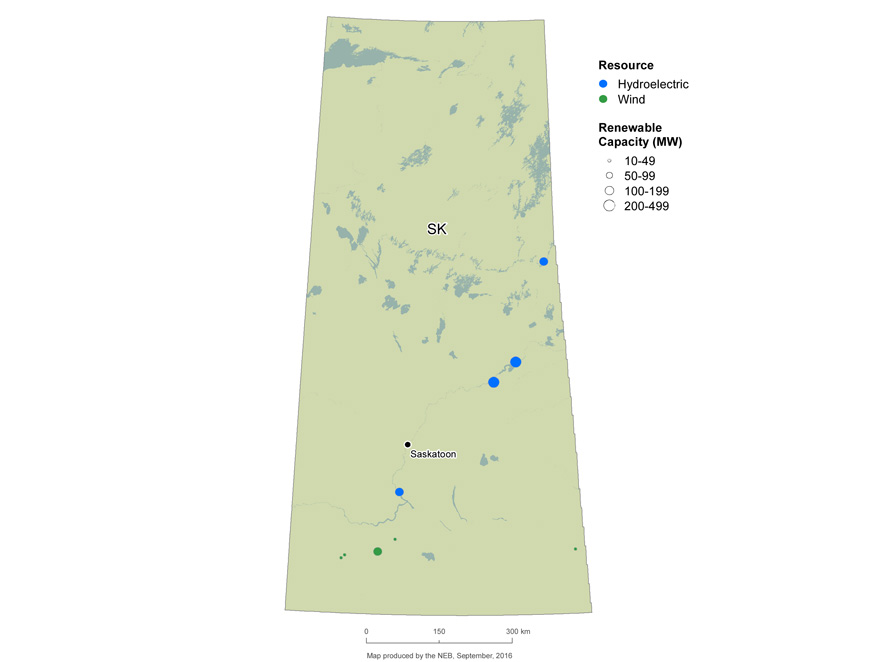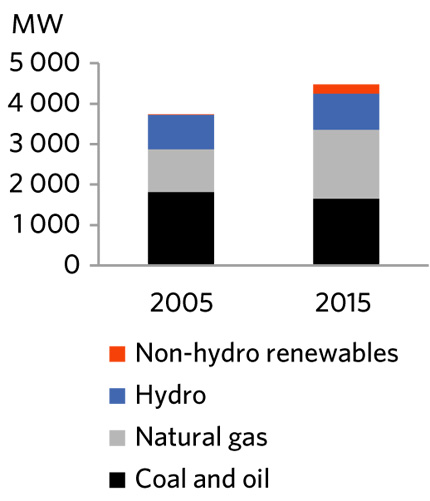ARCHIVED – Canada’s Renewable Power Landscape 2016 – Energy Market Analysis
This page has been archived on the Web
Information identified as archived is provided for reference, research or recordkeeping purposes. It is not subject to the Government of Canada Web Standards and has not been altered or updated since it was archived. Please contact us to request a format other than those available.

Saskatchewan
Renewable capacity in Saskatchewan reached 1 115 MW (25% of total capacity) in 2015. Hydroelectric plants provide 889 MW of capacity, a figure almost unchanged since 2005. The province’s five wind farms have a combined capacity of 221 MW. Hydro and wind were used to generate 17% of Saskatchewan’s electricity in 2015.
Between 2005 and 2014, about 22% of electricity in Saskatchewan was produced from renewable resources. This figure changes each because of fluctuations in hydroelectric generation. Electricity demand in Saskatchewan has increased at a relatively strong pace in the last few years so the share of renewable generation has remained relatively stable even though renewable generation has increased.
Most capacity belongs to SaskPower, the principal electric utility company and the rest is operated by independent power producers.
Coal remains the most important source of power generation, followed by natural gas, hydro and wind. Electricity generation from the province’s three coal- fired plants is reliable and relatively low cost.
SaskPower Centennial Wind Power Facility was once the biggest wind facility in Canada. The 150 MW facility was developed in 2006 under the provincial Green Power Portfolio program.
Between 2010 and 2015, independent power producers built three additional wind farms following RFPs by SaskPower.
In 2015 SaskPower set a target of 50% renewable power by 2030. To achieve this goal, the share of renewables in the capacity mix must double in the next 15 years. In addition to wind capacity, the province also plans to develop solar projects.
SaskPower offers several programs to encourage the use of renewables and flare gas. Although natural gas is not a renewable resource, the programs support generation of electricity from natural gas which would otherwise be flared into the environment.
Small producers with up to 100 kW of capacity can offset or sell their production through Net Metering or Small Power Producers programs. Flare Gas Power Generation Program supports small and medium-sized oil producers who want to generate power from gas that would have been flared.
With the launch of the Boundary Dam Carbon Capture Project in 2014, SaskPower pioneered the use of CCS technology which cuts emissions from existing coal-fired plants.
| Capacity in MW and % | Generation in GW.h and % | |||
|---|---|---|---|---|
| 2005 | 2015 | 2005 | 2015 | |
| Hydro | 854 | 889 | 4 573 | 3 426 |
| 23% | 20% | 23% | 15% | |
| Wind | 16 | 221 | 92 | 684 |
| 0.4% | 5% | 0.5% | 3% | |
| All renewable sources | 870 | 1 115 | 4 665 | 4 110 |
| 23% | 25% | 23% | 17% | |
| All sources | 3 743 | 4 477 | 19 910 | 23 599 |
This table shows Saskatchewan's electric capacity and generation from renewables in 2005 and 2015. The share of hydro in total capacity decreased from 23% to 20% while the share of wind increased from 0.4% to 5%. The share of hydro in total generation decreased from 23% to 15% while the share of wind increased from 0.5% to 3%.
FIGURE 9 Renewable Resources and Capacity in Saskatchewan

Text version of this map
This map shows the location and approximate capacity of renewable power plants with a capacity of at least 10 MW across Saskatchewan. The majority of wind resources are located south, while hydroelectric resources are located east and further north. There are no solar or biomass resources with a capacity of at least 10 MW.
FIGURE 10 Electric Generation Capacity in Saskatchewan

Text version of this graphic
This bar graph shows Saskatchewan’s total electric capacity in 2005 and 2015 for all fuel sources. Capacity has increased from 3 743 MW to 4 477 MW, with renewables increasing from 23% to 25% of total capacity.
Carbon capture and storage (CCS) technology
CCS technology captures CO2 emissions from power plants or industrial processes and stores them underground in depleted oil and gas fields or geological formations.
The 115 MW unit 3 at the Boundary Dam Coal plant in Saskatchewan, retrofitted with CCS technology in 2014, is the first large-scale power sector CCS project in the world. The technology will reduce SO2 emissions by up to 100% and CO2 emissions by up to 90%. CO2 emissions from Boundary Dam unit 3 are used to enhance recovery of oil from neighbouring oilwells. The rest is stored in an underground aquifer.
- Date modified:
